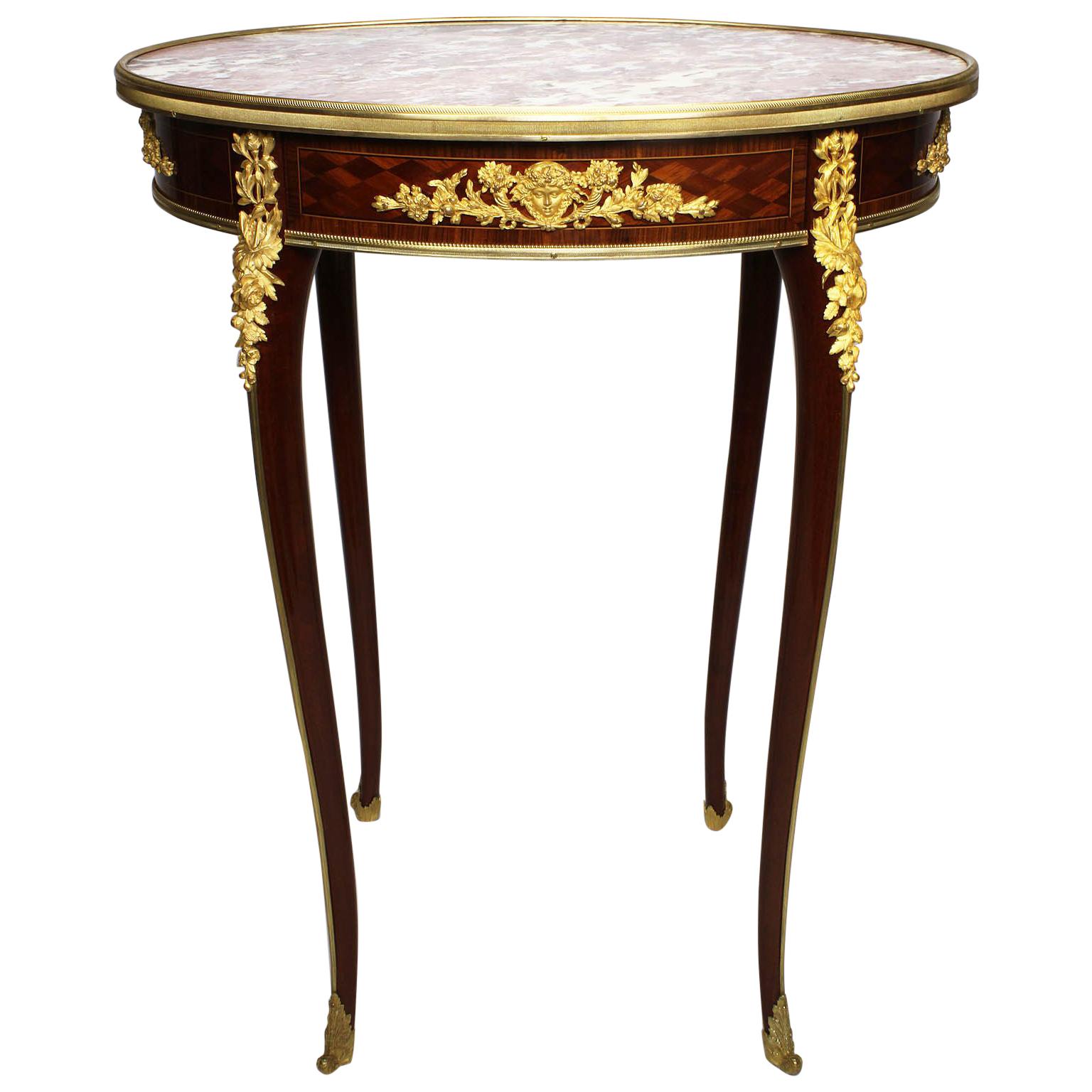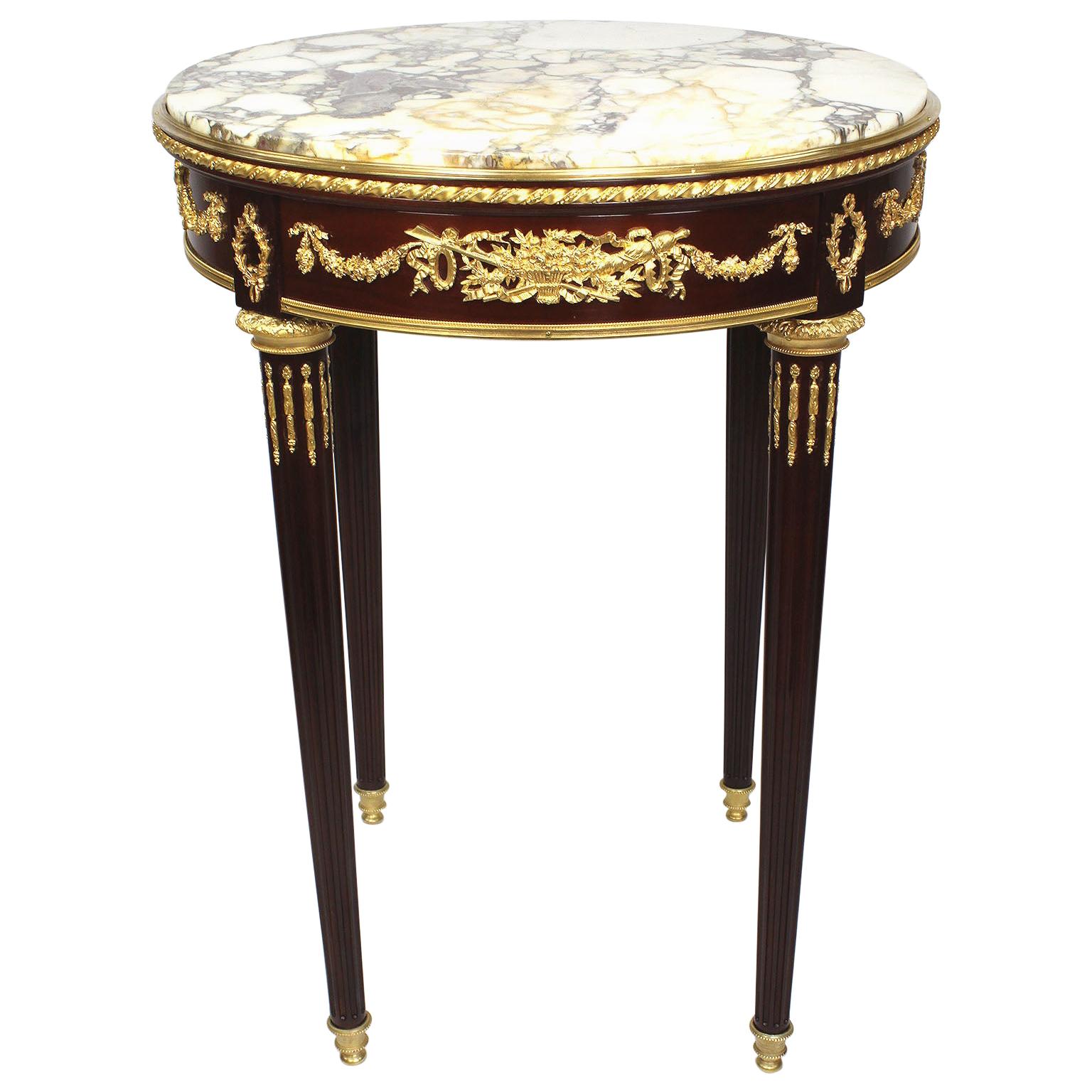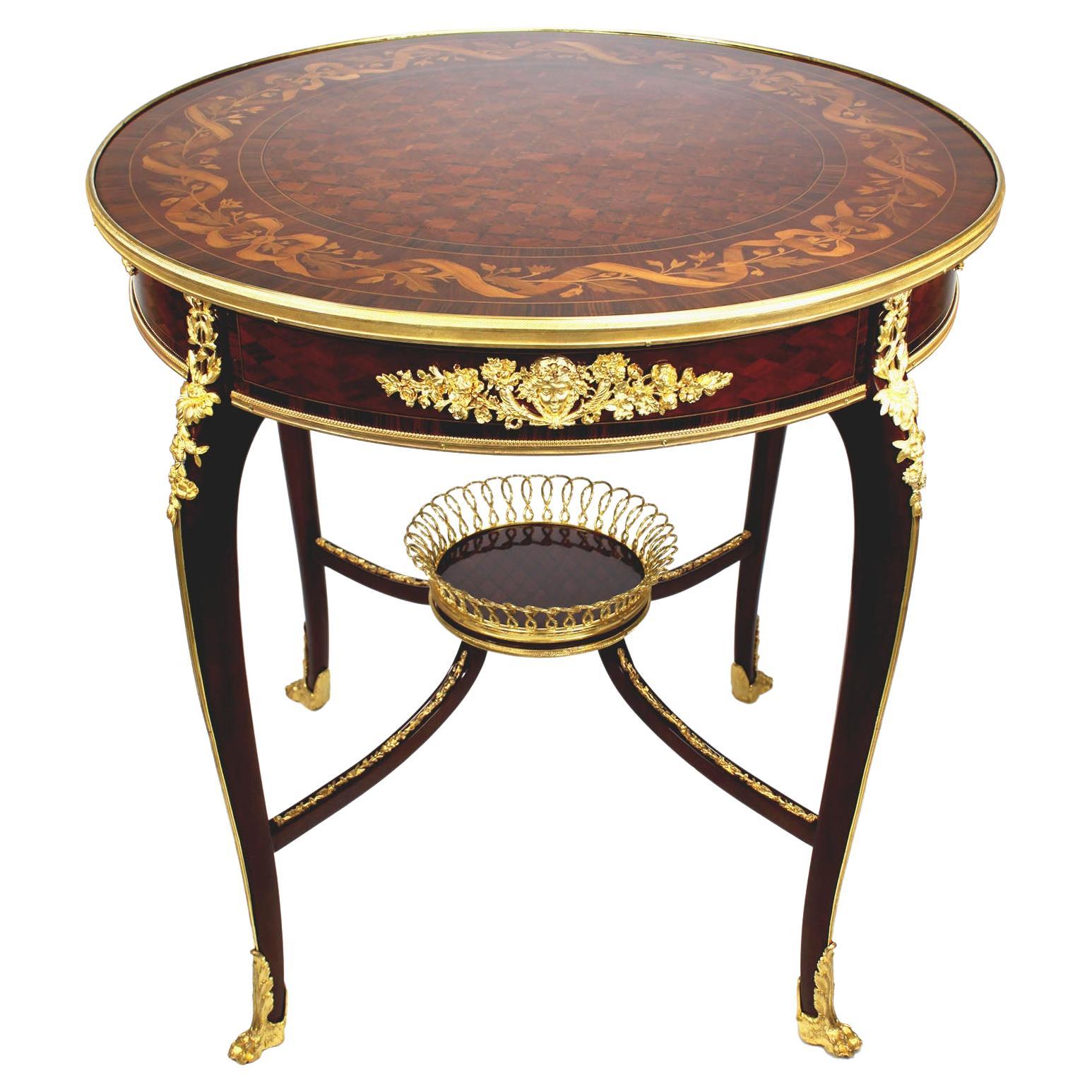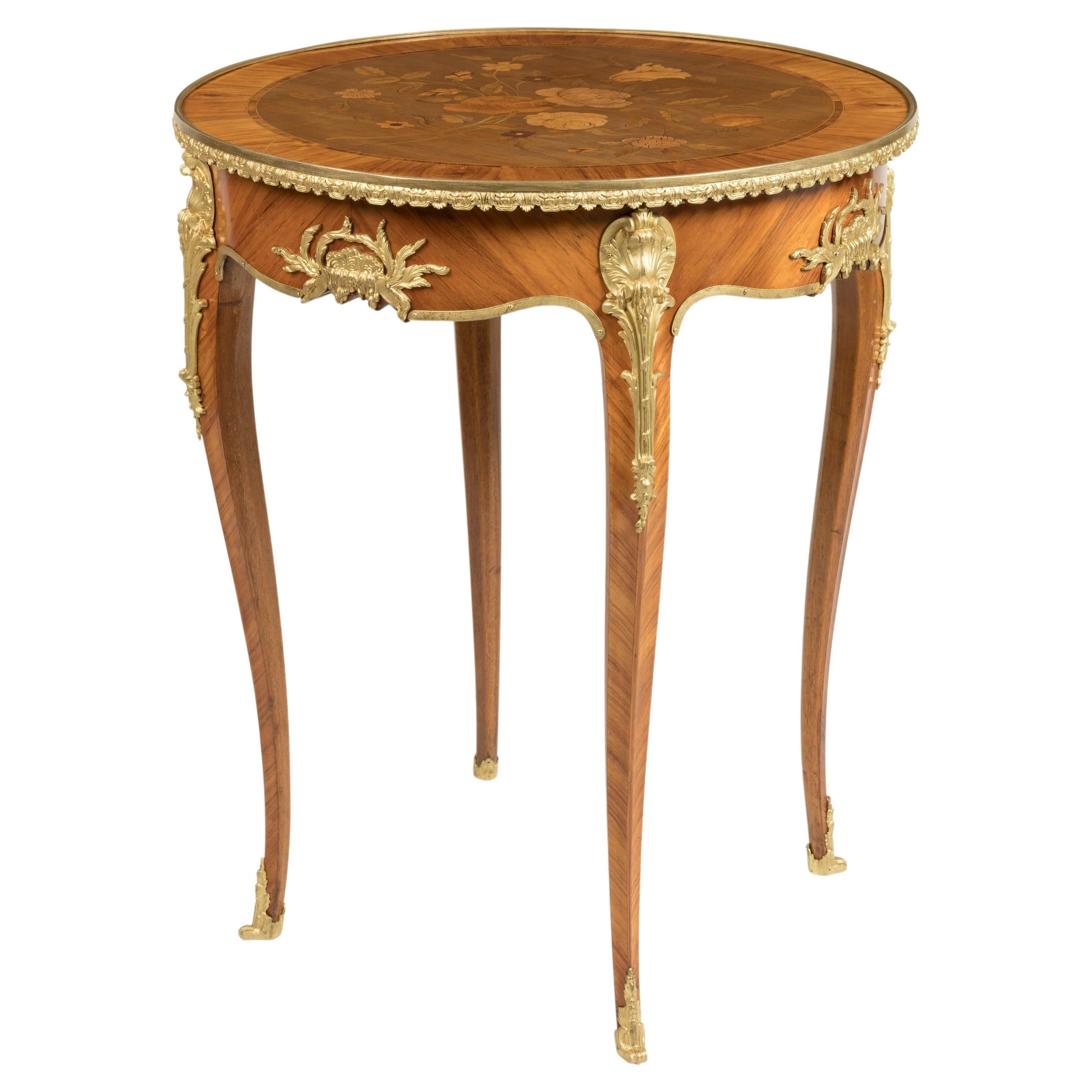Items Similar to Antique French Parquetry Ormolu Mounted Stand Att François Linke, 19th Century
Want more images or videos?
Request additional images or videos from the seller
1 of 21
Antique French Parquetry Ormolu Mounted Stand Att François Linke, 19th Century
About the Item
This is a fine antique French ormolu mounted mahogany and specimen wood parquetry stand firmly attributed to François Linke, Circa 1890 in date.
The square galleried top features beautiful parquetry decoration with ebony and box-wood stringing. The frieze is decorated with striking ormolu panels with anthemion mounts and one side is fitted with a pull out slide.
The square tapering ormolu mounted splayed out legs were designed to give more stability and are united by a shaped stretcher with flambeau finial.
This lovely stand is certain to become a talking point in your home and a fine embellishment to your reception room.
A similar stand, with a green onyx top, typical slender legs and shaped stretcher is illustrated by Christopher Payne in François Linke (1855-1946) 'The Belle Epoque of French Furniture', p. 53, pl. 44. It is described as a stand or gaine and titled by Linke as 'Pedestal Louis XVI acajou et bronzes dorés', index number 56. It was available with or without a slide and a drawer, priced between 400 and 500 francs. A comparable version is also shown as a pencil drawing from Linke's Daybook and illustrated in Payne, p. 474.
THE BOTANICAL NAME FOR THE MAHOGANY THIS ITEM IS MADE OF IS SWIETENIA MACROPHYLLA AND THIS TYPE OF MAHOGANY IS NOT SUBJECT TO CITES REGULATION.
Condition:
In really excellent condition, please see photos for confirmation.
Dimensions in cm:
Height 84 x width 37 x depth 37
Dimensions in inches:
Height 2 foot, 9 inches x width 1 foot, 3 inches x depth 1 foot, 3 inches
FRANÇOIS LINKE (CZECH REPUBLIC, 1855–1946)
François Linke, the most important French ébéniste of his time. Born in Bohemia in 1855, Linke moved to Paris in 1881 where he established his now-famous workshop and showroom. Linke's superior work spread quickly through France and he soon eclipsed even the finest furniture houses of Paris. Today, Linke is counted among the most important furniture makers of the late 19th and early 20th centuries, and his work is dearly coveted by collectors. Linke is celebrated for designing highly innovative furnishings by infusing the Rococo style with the Art Nouveau trends of Paris and this Louis XV style desk exemplifies his highly original style.
- Attributed to:François Linke (Maker)
- Dimensions:Height: 33.08 in (84 cm)Width: 14.57 in (37 cm)Depth: 14.57 in (37 cm)
- Materials and Techniques:
- Place of Origin:
- Period:
- Date of Manufacture:circa 1890
- Condition:
- Seller Location:London, GB
- Reference Number:
About the Seller
5.0
Platinum Seller
These expertly vetted sellers are 1stDibs' most experienced sellers and are rated highest by our customers.
Established in 1983
1stDibs seller since 2012
1,205 sales on 1stDibs
Typical response time: <1 hour
Associations
LAPADA - The Association of Arts & Antiques Dealers
- ShippingRetrieving quote...Ships From: London, United Kingdom
- Return PolicyA return for this item may be initiated within 14 days of delivery.
More From This SellerView All
- Antique French Parquetry Ormolu Mounted Vitrine Cabinet 19th CLocated in London, GBThis is a beautiful antique French Louis Revival parquetry and ormolu mounted breakront vitrine, circa 1860 in date. This beautiful cabinet has exquisite parquetry and crossbanded ...Category
Antique 1860s French Cabinets
MaterialsMarble, Ormolu
- Antique French Parquetry & Marquetry Occasional Table 19th CLocated in London, GBThis is a beautiful antique French Louis Revival parquetry and marquetry ormolu mounted serpentine side table / teapoy kettle stand, circa 1850 in date. The ormolu banded top has a ...Category
Antique 1850s French Side Tables
MaterialsOrmolu
- Antique French Empire Revival Ormolu Mounted Desk, 19th CenturyLocated in London, GBThis is an exquisite French Empire Revival pedestal desk, circa 1880 in date. This desk has been beautifully crafted from flame mahogany. The top has a striking gold tooled black leather inset writing surface which has a decorative geometric inlaid satinwood and ebony border around it. It features beautifully cast gilded Ormolu mounts including angels, pharaonic herms above paw feet and swan escutcheons. It is further enhanced with male masks wearing nemes headress's on the sides, making it an incredibly imposing and impressive item of furniture. The desk features seven drawers for maximum storage, it is freestanding with a beautifully panelled back and comes complete with the original working locks and keys. This desk will soon become the centrepiece of your furniture collection, there is no mistaking the sophisticated quality and design and it is certain to enhance the style and elegance of any living area, bedroom, or reception. THE BOTANICAL NAME FOR THE MAHOGANY THIS ITEM IS MADE OF IS SWIETENIA MACROPHYLLA AND THIS TYPE OF MAHOGANY IS NOT SUBJECT TO CITES REGULATION. Condition: In excellent condition having been beautifully cleaned, French polished, waxed and releathered in our workshops, please see photos for confirmation. Dimensions in cm: Height 76 x width 150 x depth 80 Dimensions in inches: Height 29.9 x width 59.1 x depth 31.5 Empire style, is an early 19th century design movement in architecture, furniture, other decorative arts, and the visual arts followed in Europe and America until circa 1830. The style originated in and takes its name from the rule of Napoleon I in the First French Empire, where it was intended to idealize Napoleon's leadership and the French state. The style corresponds to the Biedermeier style in the German-speaking lands, Federal style in the United States and to the Regency style in Britain. The previous style was called Louis XVI style, in France. The Empire style was based on aspects of the Roman Empire. It is the second phase of neoclassicism which is also called "Directoire", after a government system. Furniture typically had symbols and ornaments borrowed from the glorious ancient Greek and Roman empires. The furniture was made from heavy woods such as mahogany and ebony, imported from the colonies, with dark finishes often with decorative bronze mounts. Marble tops were popular as were Egyptian motifs like sphinxes, griffins, urns and eagles and the Napoleonic symbols, the eagle, the bee, the initials "I" and a large "N." Gilded bronze (ormolu) details displayed a high level of craftsmanship. Flame mahogany Thomas Sheraton - 18th century furniture designer, once characterized mahogany as "best suited to furniture where strength is demanded as well as a wood that works...Category
Antique 1880s French Empire Revival Desks and Writing Tables
MaterialsOrmolu
- Antique French Kidney Occasional Side Table 19th CenturyLocated in London, GBThis is a beautiful antique French kidney shaped occasional table, circa 1860 in date. It has been masterfully crafted from beautiful wood with a star burst design and gallered sides over a shaped frieze with a drawer. It is raised on a pair of elegant tapering cabriole legs united by an undertier with a three quarter pieced brass gallery and raised on sabot mounted feet. Add a elegant touch to your home with this exceptional piece of antique French furniture...Category
Antique 1860s French Side Tables
MaterialsBrass
- Antique French Directoire Console Side Table 19th CenturyLocated in London, GBThis is a fine antique French Directoire marble topped and ormolu mounted mahogany console table, dating from Circa 1840. The shaped Carrara marble top features a decorative three quarter pieced brass gallery over a frieze drawer decorated with beaded panels. It is raised on four elegant tapering and fluted Doric columns united by an undertier on cone shaped ormolu mounted feet. It has beautifully refined proportions and retains excellent colour and patination. The Botanical name for the mahogany this item is made of is Swietenia Macrophylla and this type of mahogany is not subject to cites regulation. Condition: In excellent condition having been beautifully cleaned, polished and waxed in our workshops, please see photos for confirmation. Dimensions in cm: Height 87 x Width 87 x Depth 32 Dimensions in inches: Height 2 foot, 10 inches x Width 2 foot, 10 inches x Depth 1 foot, 1 inch Directoire style was a period in the decorative arts, fashion, and especially furniture design in France concurrent with the Directory (November 2, 1795–November 10, 1799), the later part of the French Revolution. The style uses Neoclassical architectural forms, minimal carving, planar expanses of highly grained veneers, and applied decorative painting. It is a style transitional between Louis XVI and Empire. The Directoire style was primarily established by the architects and designers Charles Percier (1764–1838) and Pier François Léonard Fontaine (1762–1853). In its use of Neoclassical architectural form and decorative motifs the style anticipates the slightly later and more elaborate Empire style, which was introduced after Napoleon established the First French Empire. It reflected the Revolutionary belief in the values of republican Rome. Ormolu - Gilt Bronze (from French 'or moulu', signifying ground or pounded gold) is an 18th-century English term for applying finely ground, high-carat gold in a mercury amalgam to an object of bronze.The mercury is driven off in a kiln leaving behind a gold-coloured veneer known as 'gilt bronze'. The manufacture of true ormolu employs a process known as mercury-gilding or fire-gilding, in which a solution of nitrate of mercury is applied to a piece of copper, brass, or bronze, followed by the application of an amalgam of gold and mercury. The item was then exposed to extreme heat until the mercury burned off and the gold remained, adhered to the metal object. Carrara marble - is a type of white or blue-grey marble popular for use in sculpture and building decor. It is quarried at the city of Carrara in the province of Massa-Carrara (Tuscany, Italy). Carrara marble has been used since the time of Ancient Rome; the Pantheon and Trajan's Column in Rome are constructed of it. Many sculptures of the Renaissance, such as Michelangelo's David, were carved from Carrara marble. For Michelangelo at least, Carrara marble was valued above all other stone, except perhaps that of his own quarry in Pietrasanta. The Marble Arch in London and the Duomo di Siena are also made from this stone, as are the interiors of Manila Cathedral, the cold-white marbles of the Sheikh Zayed Mosque and the campus of Harvard Medical...Category
Antique 1840s French Directoire Side Tables
MaterialsMarble, Ormolu
- Antique Petite French Ormolu Mounted Bureau Plat 19th CLocated in London, GBThis is an fine and beautiful petite French Louis XV Revival goncalo alves and ormolu mounted bureau plat, circa 1850 in date. This fantastic bureau plat features an ornate serpenti...Category
Antique 1850s French Louis XVI Desks and Writing Tables
MaterialsWood
You May Also Like
- French 19th Century Parquetry & Ormolu Mounted Side Table Attr. François LinkeBy François LinkeLocated in Los Angeles, CAA fine French 19th century gilt-bronze (Ormolu) mounted, mahogany and tulipwood marquetry oval Gueridon (side) table with marble top, attributed to François Linke (1855-1946). The in...Category
Antique Late 19th Century French Louis XV Gueridon
MaterialsMarble, Ormolu
- French 19th Century Mahogany & Ormolu Guéridon Side-Table, Attr. François LinkeBy François LinkeLocated in Los Angeles, CAA very fine French 19th-20th century Louis XVI style mahogany and gilt bronze (Ormolu) mounted guéridon side table with marble top, attributed to François Linke, (1855-1946). The sin...Category
Antique Early 1900s French Louis XVI Gueridon
MaterialsOrmolu
- French 19th-20th Century Circular Marquetry & Ormolu Table, Attr. François LinkeBy François LinkeLocated in Los Angeles, CAA Very Fine French Late 19th/Early 20th Century Louis XV Style Ormolu Mounted Kingwood, Bois Satine, Mahogany, Marquetry and Parquetry Gueridon (Round End-Table), Attributed to François Linke (1855-1946). The circular marquetry top with trellis inlay encompass by a ribbon-tied floral and ribbon entwining inlaid surround, above a frieze interspersed with four abundant floral, foliate and entwined opposing cornucopia mounts each centered by a bacchanal mask, with one frieze drawer, on slender cabriolet legs with an up swept X-stretcher surmounted by a circular under-tier with a basket weave mounted gallery. Bearing the fine quality furnishings retailer's plaque which reads: 'S. & H. Jewell, 131 & 132, High Holborn, London, W.C'. Circa: Paris, 1900. S & H Jewell are first recorded in 1830 as fine quality retailers, restorers and cabinet makers. They were a family business who worked from their premises at 29-31 Little Queen Street, Holborn, in London and then later to 26 Parker Street and then at 131 - 131, High Holborn, both in London W.C. They are recorded to have sold furniture to the Arts and Crafts home...Category
Antique Early 1900s Louis XV Side Tables
MaterialsBronze, Ormolu
- 19th Century Marquetry Inlaid & Ormolu Table attributed to François LinkeBy François LinkeLocated in London, GBA Very Fine Marquetry Inlaid Occasional Table Firmly Attributed to François Linke This fine table, closely related to other examples by François Linke, is...Category
Early 20th Century French Side Tables
MaterialsOrmolu
- Francois Linke Louis XV Style Ormolu Mounted Kingwood & Parquetry Mueble d'appuiBy François LinkeLocated in West Palm Beach, FLFrancois Linke (1855-1946) A Louis XV style ormolu mounted Kingwood and parquetry mueble d'appui, by Francois Linke, Index Number 204, For Maison Krieger, Paris, Early 20th Centur...Category
Early 20th Century Side Tables
- 19th Century Parquetry Inlaid Side Table, after LinkeBy François LinkeLocated in Brighton, SussexA very good quality late 19th century French Louis XVI style parquetry inlaid side table, having a hinged top, opening to reveal a compartment within. Three drawers beneath, raised o...Category
Antique Late 19th Century Louis XIV End Tables
MaterialsMahogany
Recently Viewed
View AllMore Ways To Browse
Early 19th Century French Side Table
3 French Side Table
Green French Side Tables
French Antique Side Table With Drawer
Square Antique Side Tables
X Pull Side Tables
2 Antique Side Tables
Antique One Drawer Side Table
Antique Wood Side Table With Drawer
2 Drawer Side Table
1 Drawer Side Table
French Antique Tables With Ormolu
Antique Pedestal Side Tables
19th Century One Drawer Stand
3 Table Antique French
Louis Xvi Side Table With Drawer
House Finial
Louis Xv Side Table With Bronze





